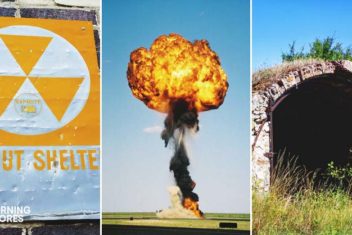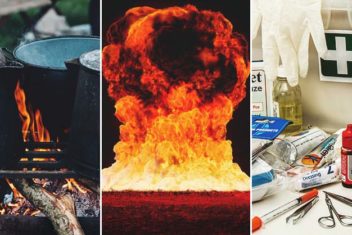Most of us can remember that day.
We all sat helplessly as we watched planes flying into buildings, people running frantically from disaster, and heard loved ones crying out on the news as they anxiously awaited to find out if those they loved had survived.
Everything changed after the 9/11 terror attacks took place. It no longer seemed far-fetched to be prepared for a natural disaster or other types of emergencies. We now know they can happen to any of us, no matter where we live.
One survival lesson I took to heart from the September 11, 2001 incident was about communication. This was even before texting and social media. People
They waited for hours to find out who was safe and who wasn’t. As I grew older, I developed an emergency communication plan detailing how I would reach others in a similar situation.
Whenever I know a natural disaster is headed our way, we review the emergency plan options, including how we’ll communicate.
If you haven’t considered how you’d communicate with loved ones amid an emergency, you should.
Here are a few ways to communicate during an emergency to help you get started:

1. An Old-Fashioned Phone

If you’re in the middle of a disaster or national emergency, your cellphone probably won’t be a viable option.
When too many people call out, the cell service becomes overloaded and you’ll be unable to get a connection. Therefore, you should pull out your old phone.
Yes, I mean the one with a cord. If you have landline service, plug it in, and use it. This may be a good reason to keep your landline service a little longer, though you may not use it as regularly as you once did.
Keep a written list of important numbers somewhere save and easily accessible, in case your cellphone battery has died.
2. Car Chargers Are a Must

If you must evacuate from an area because of an emergency, make sure you have a car charger in tow. You must be able to charge your cellphone.
This will allow you to make calls when you get out of the overloaded network area where you might not be able to use your cellphone at the time.
When you reach a calmer area, your cellphone should work again, and you should be able to notify your loved ones and let them know you’re okay.
Keep in mind that while your phone is searching for a signal, it drains the battery quicker. So have your car charger ready, and definitely consider having a mobile solar charger on hand.
3. Work Those Fingers

We’re living in an age where text messaging is king. If I can text someone without having to pick up the phone and call them, I’m guilty.
I choose texting every time.
Though this may annoy some people, texting can be a lifesaver during an emergency. If you can’t make a call, you may still be able to send a text message.
This will allow you to contact those who are worried about you, or stay in contact with your group if you’ve lost each other in the chaos.
Consider setting up a family messaging group in advance, where one message to the group will be received by all.
4. Via E-mail
E-mail is another option for communication during an emergency or disaster situation. If you can’t make a call or send a text because things are too crowded, Wi-Fi may still be on your side.
You should be able to send an e-mail to others letting them know you’re safe or allowing them to know your location.
Be sure to keep an updated list of e-mail addresses in case you need them during a difficult time, and you must communicate using this method.
5. Social Media Can Actually Help
Social media has become one of those parts of life where we’re all addicted to it, but we all secretly hate it simultaneously.
It’s full of great information, but there are things on social media every day which drives us crazy. Don’t let social media frustrate you to the point you leave it altogether because it could be a great way to communicate during an emergency.
You can log on to your social media account and either mark yourself safe, make a post to let others know you’re safe or use messaging services provided through your social media account.
6. American Red Cross
American Red Cross is an organization that shows up during natural disasters and other emergency situations.
They’re also offering a service through one of their websites to help people communicate during these times as well.
The website is known as Safe and Well. It allows people to share information with their loved ones to let them know how they’re doing and let them know they’re safe.
7. Phone Booths: They Do Exist

I laugh when I talk with my children because my younger two don’t even know what a phone booth is. They aren’t prominent in our world anymore, and my kids haven’t seen one enough to recognize it for what it is.
If you’re in a dire situation, a phone booth can help you. They do still exist, and if you Google for a phone booth location, you should be directed to one.
Phone booths are landlines. Therefore, if you don’t have landline services at your home or phone to plug into the wall, a phone booth could be your next best option.
8. Go HAM

Most people aren’t familiar with using a HAM radio, but they can be extremely helpful in tough situations.
Be sure to make the HAM radio part of your emergency communication plan. This will give you the opportunity to discuss what frequency everyone is to be on to communicate ahead of the actual tragedy.
HAM radios can reach over 10 miles by themselves, but if you add a repeater, they can reach approximately 1,500 miles.
9. Talk to the Hand
Another option for emergency communication is to use a walkie-talkie or a CB radio.
You may have to be closer to your loved ones to utilize the walkie-talkie, but the CB radio will allow you to hear what’s going on while communicating with others too.
Plus, these options are easy to travel with. A CB radio can be used in a vehicle. While walkie-talkies are light-weight and can be thrown in a backpack while you head to safety.
10. Smokin’
Let’s say you’re in a survival situation because of a disaster. Your cellphone is dead, the batteries have run low on the walkie-talkies, what should you do?
Don’t forget about smoke signals. They’re a great way to signal for help.
Also, if you’re traveling with a group, and you’ve been separated from them, smoke signals could allow the group to locate you or for you all to communicate back and forth.
In dire circumstances, smoke signals can also be a way to communicate with your close community and neighbors. By adding green branches to fire, thick smoke is created. Arrange with your neighbors beforehand what they should look out for, and what the meaning would be.
11. Mirror, Mirror on the Wall
It’s scary to let our minds go to a place where our backs are against a wall, and we’re in danger. We aren’t only trying to escape a disaster, but we don’t wish to be found either because it could mean more danger.
If you’re hiding in the woods and trying to get to your bug-out shelter with your loved ones not far behind, but you suddenly hear noises of unwanted voices, how would you communicate with your group?
One idea is to use mirror signals. It only works well during the day, but it could help you all stay in contact and avoid further danger.
12. Pull Out the Bird Call
Another option for emergency communication in a stressful situation where you don’t wish to be noticed by others is to use a bird call.
If you’re out in nature, it should go undetected by those unaware of what you’re doing. Yet, your group would know to listen for it and understand what you’re telling them.
13. Have a Flare
Again, this could send a chill up your back, but let’s say you’re in a situation where you’ve survived an emergency.
You neighborhood might be flooded and you are stuck on a roof.
Send up a flare. They work best at night but can still be seen in the day.
14. Get Artistic
The last option for communicating in an emergency will be an option if you’re separated from your group and trying to reach a safe destination.
Instead of standing around waiting for your group to find you, pull out a piece of chalk and make markings only they’d recognize to give them clues as to your condition and where you’re headed.
The chalk can be erased to avoid unwanted people from finding you. It allows you to communicate and hopefully find one another.
Make sure your whole group is taught these secret markings, and know where to make and look for them, even or especially, the kids.
There’s a method of communication listed here for almost any type of emergency. Whether you’re trying to reach out after a severe storm has rolled through and knocked the power out, or amid a national crisis, you should now know how you could communicate in an emergency with others.
Hopefully, this will give you food for thought, figure out what works best for you and your family, and incorporate emergency communication in the midst.
Be sure to train your whole family, friends,
You don’t know what tomorrow holds, and you’ll be glad you took steps to figure out your emergency communication plan before danger strikes.












